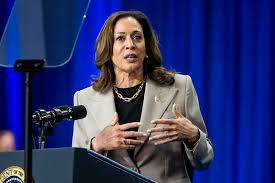
Table of Contents
Harris campaign in a recent development that has stirred discussion and debate, the campaign team for Vice President Kamala Harris has introduced an extensive list of pronoun options for job seekers applying to work on the campaign. The move, intended to promote inclusivity and respect for diverse gender identities, has sparked a variety of reactions, with critics claiming that the focus on pronouns overshadows substantive policy discussions. This article explores the details of the pronoun options, the motivations behind this initiative, and the broader implications for political campaigns and workplace inclusivity.
Details of the Pronoun Options
The Harris campaign has provided job applicants with a choice of nine different pronoun options on their application forms. The options include traditional pronouns like “he/him,” “she/her,” and “they/them,” as well as additional choices to accommodate a broader range of gender identities. The complete list of pronouns includes:
- He/Him
- She/Her
- They/Them
- Ze/Zir
- Xe/Xem
- Ey/Em
- Ve/Ver
- Per/Per
- Hu/Hum
This array of options reflects an effort to recognize and respect the diverse gender identities that individuals may have. By allowing applicants to select pronouns that align with their identity, the campaign aims to foster a more inclusive environment where all individuals feel recognized and respected.
Motivations Behind the Pronoun Options
The inclusion of multiple pronoun options on the Harris campaign job application is part of a broader effort to promote inclusivity and support for gender diversity. The motivations behind this initiative can be understood through several key points:
- Fostering Inclusivity: The campaign seeks to create a welcoming environment for people of all gender identities. By offering a range of pronoun options, the Harris team aims to make it clear that they are committed to respecting each individual’s identity and fostering an inclusive workplace culture.
- Reflecting Progressive Values: Vice President Kamala Harris and her campaign team have positioned themselves as champions of progressive values, including LGBTQ+ rights and gender equality. The emphasis on pronoun inclusivity aligns with these values and demonstrates a commitment to advancing social justice issues.
- Promoting Respect and Understanding: Providing a variety of pronoun options helps raise awareness about different gender identities and encourages understanding. It can also serve as an educational opportunity for those who may be unfamiliar with the range of pronouns and their significance.
- Aligning with Modern Workplace Practices: Many organizations and institutions are adopting similar practices as part of their commitment to diversity and inclusion. By including a broad spectrum of pronouns, the Harris campaign aligns itself with contemporary trends in workplace inclusivity and reflects a modern approach to gender identity.
Criticism and Concerns
The Harris campaign’s focus on pronouns has not been without its critics. Several concerns and criticisms have emerged:
- Perceived Distraction from Policy: Critics argue that the emphasis on pronouns may divert attention from substantive policy issues. They contend that focusing on pronouns, while important for inclusivity, could be seen as a symbolic gesture that does not address pressing policy concerns or offer concrete solutions to voters’ issues.
- Public and Media Reactions: The media and public response to the pronoun options has been mixed. Some commentators have praised the campaign for its commitment to inclusivity, while others have mocked or questioned the necessity of such a broad range of pronouns. This has led to a polarized debate about the role of pronoun inclusivity in political campaigns.
- Potential Alienation: There is a concern that the focus on pronouns might alienate some voters who may feel that the emphasis on gender identity issues overshadows other important aspects of the campaign. Critics argue that balancing inclusivity with a focus on policy is essential to avoid alienating potential supporters.
- Implementation and Practicality: Questions have been raised about the practical implications of offering such a wide range of pronouns. Some individuals have expressed doubts about how these pronouns will be used in practice and whether they will effectively contribute to a more inclusive environment or merely serve as a symbolic gesture.
Broader Implications for Political Campaigns
The introduction of multiple pronoun options by the Harris campaign has broader implications for how political campaigns address issues of diversity and inclusion:
- Setting a Precedent: The Harris campaign’s approach may set a precedent for other political campaigns and organizations. As inclusivity becomes an increasingly important issue, other campaigns may follow suit by incorporating similar practices into their hiring processes and public communications.
- Shaping Campaign Strategies: Campaigns will need to navigate the balance between promoting inclusivity and addressing voters’ policy concerns. The Harris campaign’s experience could provide insights into how to effectively integrate diversity initiatives without detracting from policy discussions.
- Influencing Workplace Practices: The emphasis on pronoun inclusivity reflects a growing trend in workplace practices. As more organizations adopt similar policies, the focus on pronouns may become a standard aspect of promoting inclusivity and respect in various professional environments.
- Public Perception of Inclusivity: The public’s response to the Harris campaign’s pronoun options underscores the complex dynamics of inclusivity in politics. Campaigns will need to consider how their efforts to promote diversity are perceived and ensure that such initiatives are perceived as genuine and aligned with broader goals.
Conclusion
The Harris campaign’s decision to offer nine different pronoun options for job seekers has sparked a significant and multifaceted debate. While the move is intended to promote inclusivity and respect for diverse gender identities, it has also raised questions about the balance between symbolic gestures and substantive policy discussions.
As the campaign continues, the focus will be on how it manages the intersection of inclusivity and policy, and how other political campaigns and organizations respond to this evolving aspect of workplace and political culture. The outcome of this debate will likely influence future approaches to diversity and inclusion in political campaigns and beyond, highlighting the ongoing challenge of integrating progressive values with effective governance and public engagement.







